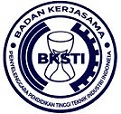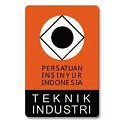Analisis Kecacatan Produk Pada Mesin Pemotongan Dengan Menggunakan Metode FMEA di UD. Abdi Rakyat
Abstract
Full Text:
PDFReferences
C. Park, “A BN driven FMEA approach to assess maritime cybersecurity risks,” Ocean Coast. Manag., vol. 235, 2023, doi: 10.1016/j.ocecoaman.2023.106480.
H. Zhang, “Practice and Research on FMEA of Telecommunication Satellite System,” Lecture Notes in Electrical Engineering, vol. 917. pp. 921–930, 2023. doi: 10.1007/978-981-19-3387-5_110.
S. W. Lin, “An FMEA model for risk assessment of university sustainability: using a combined ITARA with TOPSIS-AL approach based neutrosophic sets,” Ann. Oper. Res., 2023, doi: 10.1007/s10479-023-05250-4.
B. O. Ceylan, “A novel FMEA approach for risk assessment of air pollution from ships,” Mar. Policy, vol. 150, 2023, doi: 10.1016/j.marpol.2023.105536.
N. H. Moghimi, “Recognising and prioritising the supply chain risk in project-based organisation regarding the effective environmental factors and by using FMEA technique case study: Ehdas Gostar Nirooye Pars Co.,” Int. J. Procure. Manag., vol. 16, no. 2, pp. 307–325, 2023, doi: 10.1504/IJPM.2021.10041087.
A. Alvand, “Identification and assessment of risk in construction projects using the integrated FMEA-SWARA-WASPAS model under fuzzy environment: a case study of a construction project in Iran,” Int. J. Constr. Manag., vol. 23, no. 3, pp. 392–404, 2023, doi: 10.1080/15623599.2021.1877875.
Y. E. Priharanto, “Risk Assessment of the Fishing Vessel Main Engine by Fuzzy-FMEA Approach,” J. Fail. Anal. Prev., 2023, doi: 10.1007/s11668-023-01607-w.
I. N. Permadi and D. B. Nisa, “A Model Experiment Design Using the Taguchi Method: A Case Study Of Making Concrete Roof,” J. Ris. Ilmu Tek., vol. 1, no. 1, pp. 36–44, 2023.
T. M. Sari and W. Dini, “Risk Assessment and Mitigation Strategy in The Halal Broiler Supply Chain,” J. Ris. Ilmu Tek., vol. 1, no. 1, pp. 13–24, 2023.
S. ALMashaqbeh, “Healthcare waste hazards assessment using EWGM-FMEA: Case study in Oman,” Cogent Eng., vol. 10, no. 1, 2023, doi: 10.1080/23311916.2023.2185951.
M. Ikhsan, “The Integration of Six Sigma and FMEA Methods in Determining Crude Palm Oil (CPO) Quality Improvement Factors at the Cot Girek Palm Oil Mill Unit of Pt. Perkebunan Nusantara-1,” Lecture Notes in Mechanical Engineering. pp. 1–13, 2023. doi: 10.1007/978-981-19-3629-6_1.
A. Mohammed, “An integrated fuzzy-FMEA risk assessment approach for reinforced concrete structures in oil and gas industry,” J. Intell. Fuzzy Syst., vol. 44, no. 1, pp. 1129–1151, 2023, doi: 10.3233/JIFS-221328.
F. Pohan, I. Saputra, and R. Tua, “Scheduling Preventive Maintenance to Determine Maintenance Actions on Screw Press Machine,” J. Ris. Ilmu Tek., vol. 1, no. 1, pp. 1–12, 2023.
G. Filhaq, S. Aprianto, and H. Alfianto, “Design of Smart Locker Door Using Quality Function Deployment Based on ATMega 2560 Microcontroller,” J. Ris. Ilmu Tek., vol. 1, no. 1, pp. 25–35, 2023.
V. C. Dewi, V. Amrizal, and F. E. M. Agustin, “Implementation of Adaptive Neuro-Fuzzy Inference System and Image Processing for Design Applications Paper Age Prediction,” J. Ris. Ilmu Tek., vol. 1, no. 1, pp. 45–57, 2023.
S. Mozaffari, “Environmental, Health, and Safety Risk Assessment in Marun’s oil Field using the FMEA Method,” Pet. Coal, vol. 65, no. 1, pp. 164–171, 2023, [Online]. Available: https://api.elsevier.com/content/abstract/scopus_id/85148208744
G. Minguito, “Risk management in humanitarian supply chain based on FMEA and grey relational analysis,” Socioecon. Plann. Sci., 2023, doi: 10.1016/j.seps.2023.101551.
M. A. Zahed, “Simultaneous assessment of health, safety, and environmental risks using William Fine and FMEA methods based on OHSAS 18001: 2007 standard in the Alborz tunnel, Iran,” Geomech. und Tunnelbau, vol. 16, no. 1, pp. 103–113, 2023, doi: 10.1002/geot.202100093.
A. Pacana, “Method of Fuzzy Analysis of Qualitative-Environmental Threat in Improving Products and Processes (Fuzzy QE-FMEA),” Materials (Basel)., vol. 16, no. 4, 2023, doi: 10.3390/ma16041651.
S. Indrawati, “Integration of Six Sigma, FMEA and TRIZ to improve product quality: Upright piano case application,” AIP Conference Proceedings, vol. 2482. 2023. doi: 10.1063/5.0111223.
DOI: http://dx.doi.org/10.24014/jti.v9i2.23835
Refbacks
- There are currently no refbacks.
Copyright (c) 2023 Muhammad Hafizul Aiman

This work is licensed under a Creative Commons Attribution-NonCommercial-ShareAlike 4.0 International License.
Jurnal Teknik Industri
P-ISSN 2460-898X | E-ISSN 2714-6235
Published by:
Industrial Engineering Department
Universitas Islam Negeri Sultan Syarif Kasim Riau, Indonesia
Office Address:
H.R. Soebrantas KM 15.5, Tampan, Pekanbaru, Riau, Indonesia 28293
email: jti.fst@uin-suska.ac.id
Indexed by:
JTI : Jurnal Teknik Industri under a Creative Commons Attribution-NonCommercial-ShareAlike 4.0 International License.

















